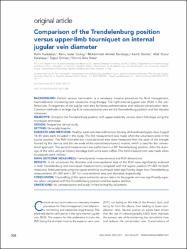Comparison of the Trendelenburg position versus upper-limb tourniquet on internal jugular vein diameter

Göster/
Erişim
info:eu-repo/semantics/openAccessTarih
2017Yazar
Karaaslan, PelinVural Gökay, Banu
Karakaya, Muhammet Ahmet
Darçın, Kamil
Karakaya, Afak Durur
Örmeci, Turgul
Köse, Emine Arzu
Üst veri
Tüm öğe kaydını gösterKünye
Karaaslan, P., Vural Gökay, B., Karakaya, M. A., Darçın, K., Karakaya, A., Örmeci, T. ... Köse, E. A. (2017). Comparison of the Trendelenburg position versus upper-limb tourniquet on internal jugular vein diameter. Annals of Saudi Medicine, 37(4), 308-312. https://dx.doi.org/10.5144/0256-4947.2017.308Özet
BACKGROUND: Central venous cannulation is a necessary invasive procedure for fluid management, haemodynamic monitoring and vasoactive drug therapy. The right internal jugular vein (RIJV) is the preferred site. Enlargement of the jugular vein area facilitates catheterization and reduces complication rates. Common methods to enlarge the RIJV cross-sectional area are the Trendelenburg position and the Valsalva maneuver. OBJECTIVE: Compare the Trendelenburg position with upper-extremity venous return blockage using the tourniquet technique. DESIGN: Prospective clinical study. SETTING: University hospital. SUBJECTS AND METHODS: Healthy adult volunteers (American Society of Anesthesiologists class I) aged 18-45 years were included in the study. The first measurement was made when the volunteers were in the supine position. The RIJV diameter and cross-sectional area were measured from the apex of the triangle formed by the clavicle and the two ends of the sternocleidomastoid muscle, which is used for the conventional approach. The second measurement was performed in a 20° Trendelenburg position. After the drainage of the veins using an Esbach bandage both arms were cuffed. The third measurement was made when tourniquets were inflated. MAIN OUTCOME MEASURE(S): Hemodynamic measurements and RIJV dimensions. RESULTS: In 65 volunteers the diameter and cross-sectional area of the RIJV were significantly widened in both Trendelenburg and tourniquet measurements compared with the supine position (P<.001 for both measures). Measurements using the upper extremity tourniquet were significantly larger than Trendelenburg measurements (P=.002 and <.001 for cross-sectional area and diameter, respectively). CONCLUSION: Channelling of the upper-extremity venous return to the jugular vein was significantly superior when compared with the Trendelenburg position and the supine position. LIMITATIONS: No catheterization and study limited to healthy volunteers.
WoS Q Kategorisi
Q3Scopus Q Kategorisi
Q3Kaynak
Annals of Saudi MedicineCilt
37Sayı
4Koleksiyonlar
- Makale Koleksiyonu [3811]
- PubMed İndeksli Yayınlar Koleksiyonu [4281]
- Scopus İndeksli Yayınlar Koleksiyonu [6648]
- WoS İndeksli Yayınlar Koleksiyonu [6722]

















